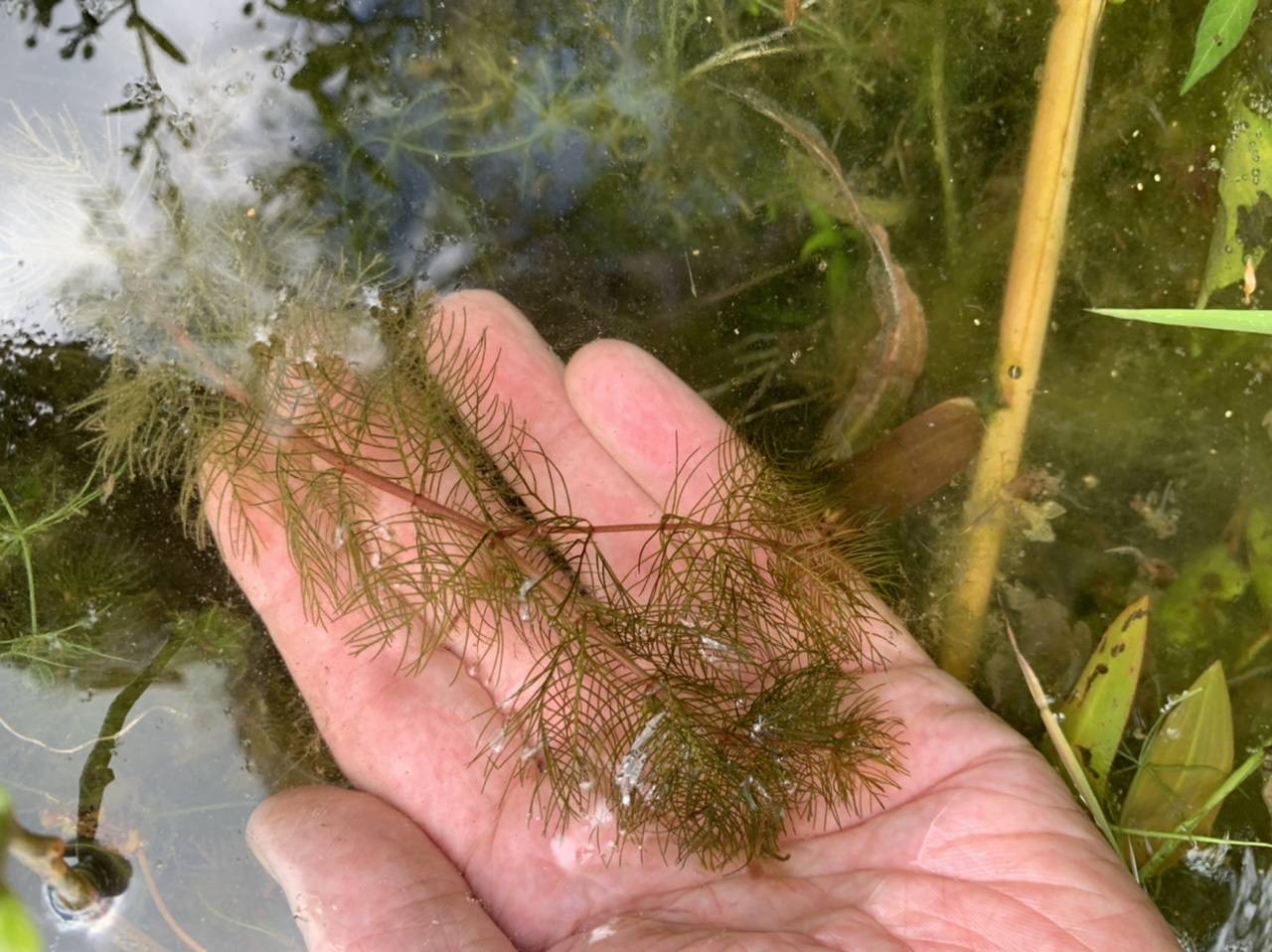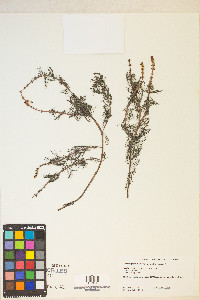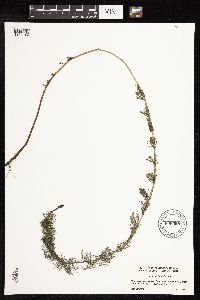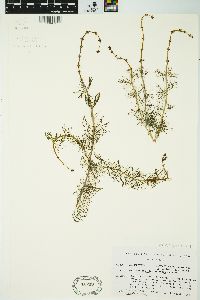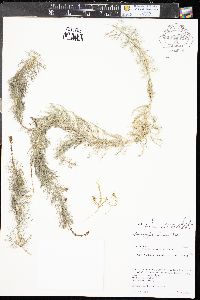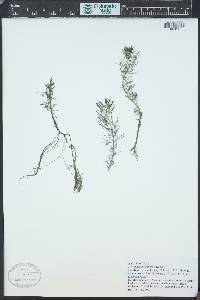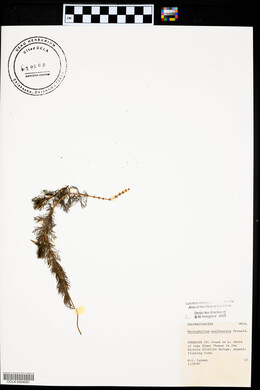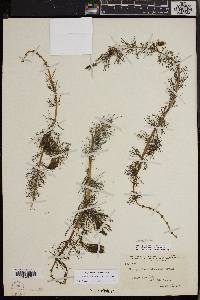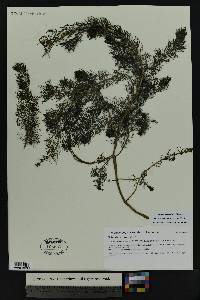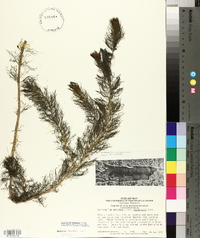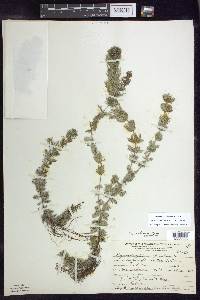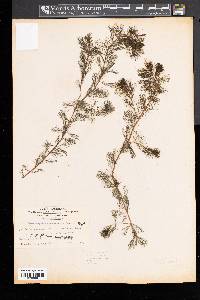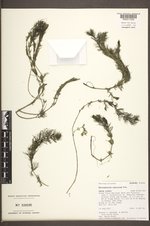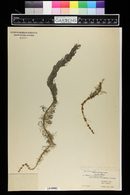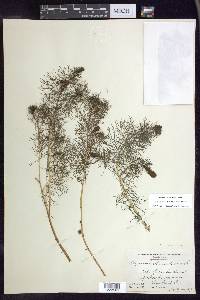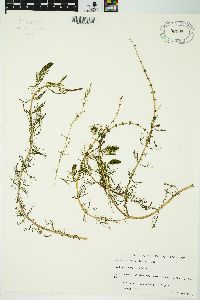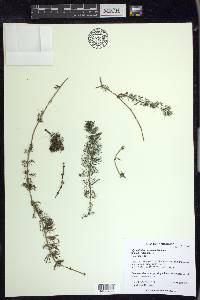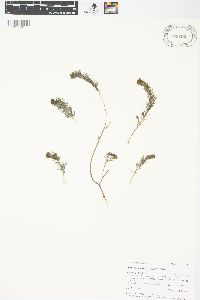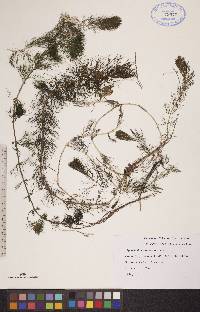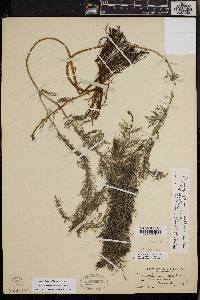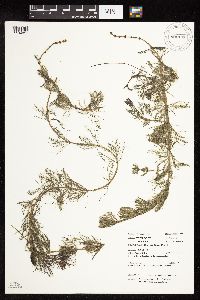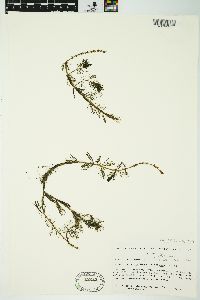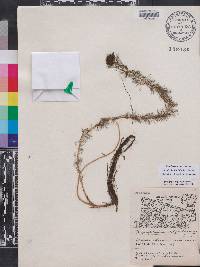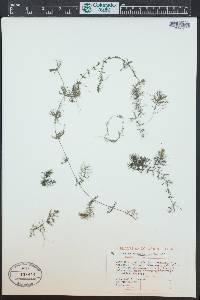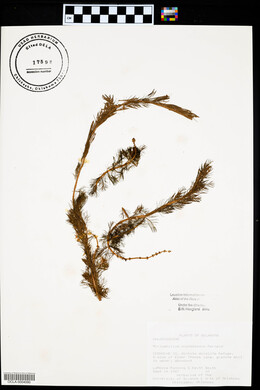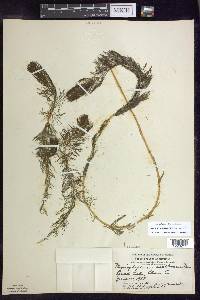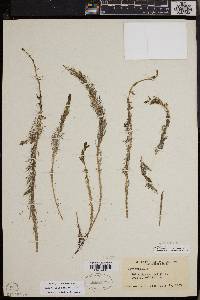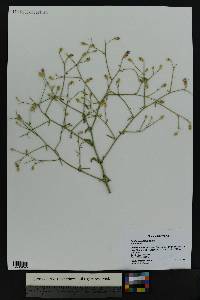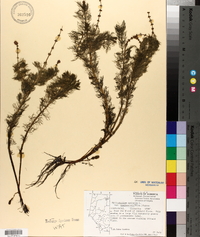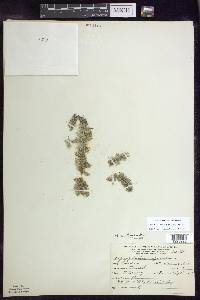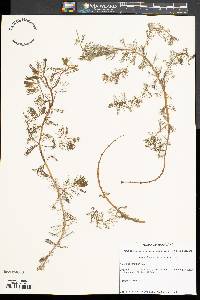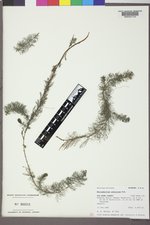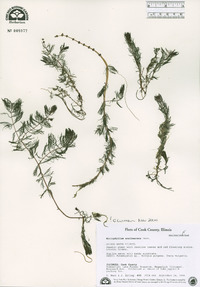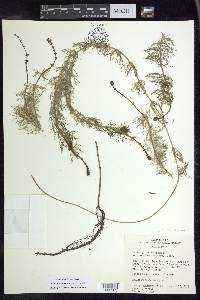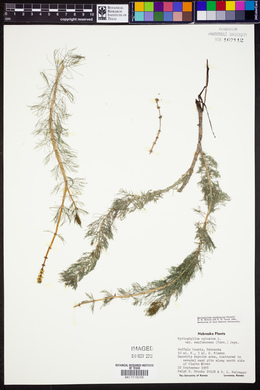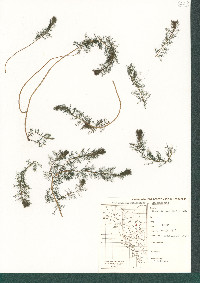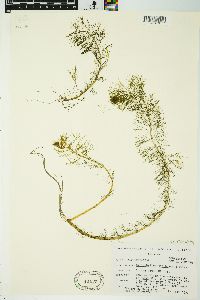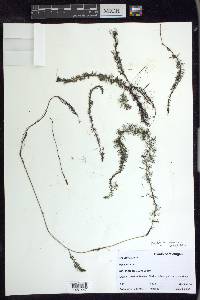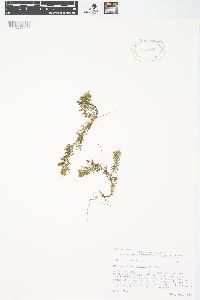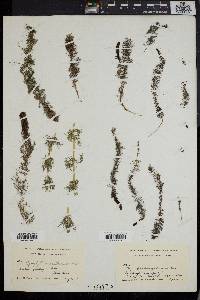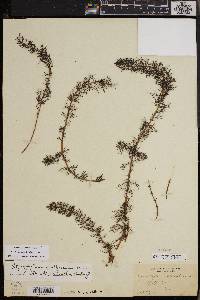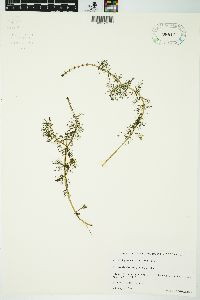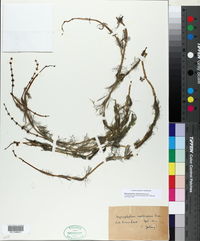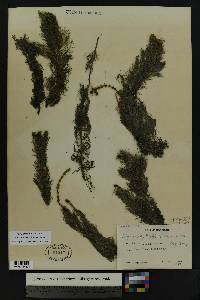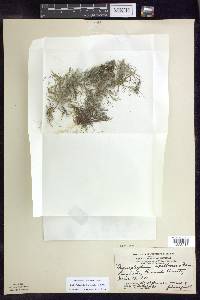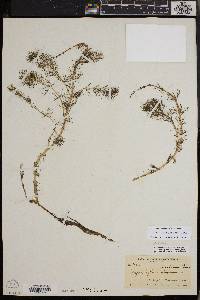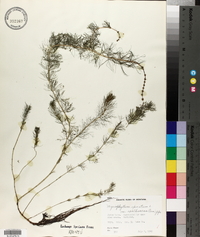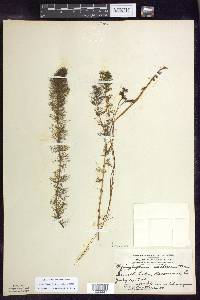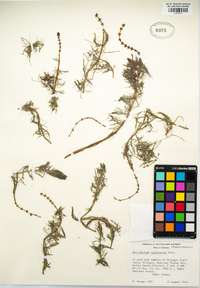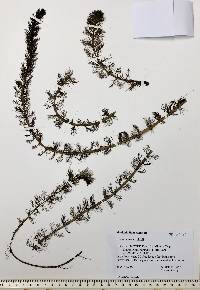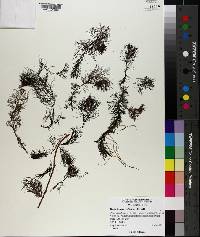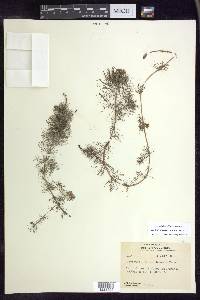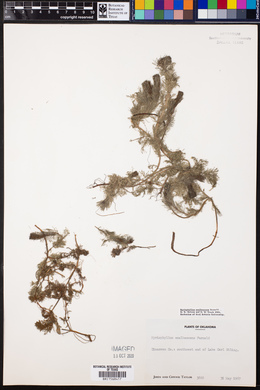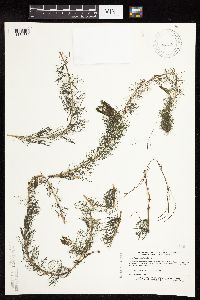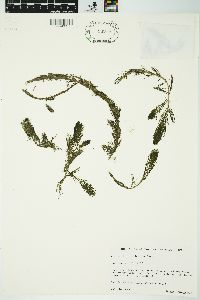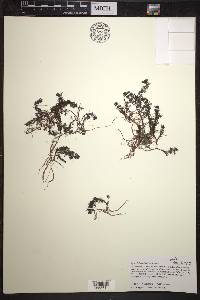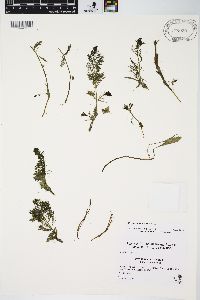Myriophyllum sibiricum
|
|
|
|
Family: Haloragaceae
Siberian Water-Milfoil, more...American watermilfoil, milfoil, shortspike watermilfoil
[Myriophyllum exalbescens Fern., moreMyriophyllum exalbescens var. magdalenense (Fern.) A. Löve, Myriophyllum magdalenense Fern., Myriophyllum spicatum subsp. exalbescens (Fern.) Hultén, Myriophyllum spicatum subsp. squamosum Laestad. ex Hartman, Myriophyllum spicatum var. capillaceum Lange, Myriophyllum spicatum var. exalbescens (Fern.) Jepson, Myriophyllum spicatum var. squamosum (Laestad. ex Hartman) Hartman] |
Perennial aquatic herb Stem: mostly submersed, unbranched or with non-interlacing branches, rarely branching near surface, stem diameter remaining even from base to just below inflorescence, internodes usually less than 1 cm long. Leaves: in whorls of three or four, 1- 5 cm long with a rounded tip on the uppermost leaves, pinnately divided with five to twelve arching divisions per side. Out of water, the leaves remain rigid. Flowers: either male or female, found on the same plant (monoecious), borne in whorls on a terminal spike (4 - 10 cm long) above the water surface, with male flowers near the inflorescence tip. Bracts do not extend past the flowers and are non-toothed on upper bracts or toothed on lower bracts. Flowers four-parted, small, greenish to pinkish, with oblong petals 2.5 mm long and eight stamens (on male flowers). Fruit: a deeply four-lobed nut-like cluster, 2.3 - 3 mm long, nearly spherical, splitting into four segments with rounded, smooth to slightly wrinkled backs. Winter buds: formed in autumn. Similar species: The non-native Myriophyllum spicatum differs by having squared tips on the upper leaves, twelve or more pairs of leaf divisions, a wider stem diameter below the inflorescence than near the base, and leaves that become limp out of water. Myriophyllum pinnatum is easy to distinguish by having both alternate and whorled leaves. Myriophyllum verticillatum has pinnately divided bracts that are longer than the flowers and well-formed winter buds that grow along the stem. Myriophyllum heterophyllum has male flowers with four stamens and bracts that are longer than the flowers. Flowering: early June to mid September Habitat and ecology: Quiet ponds and lakes that are often calcareous. Occurence in the Chicago region: native Etymology: Myriophyllum comes from the Greek words, myrios, meaning many, and phyllon, meaning leaf, referring to its highly divided leaves. Sibiricum means "from Siberia." Author: The Morton Arboretum Stems loosely erect in the water, often whitish, not much branched above, not much thickened below the infl; shoot-tip knob-like, with crowded lvs, the internodes mostly ca 1 cm or less; lvs whorled, 1-5 cm, with mostly 5-12 slender, widely arcuate segments to a side; spikes emersed, mostly 4-10 cm, with whorled bracts and fls, the fls at the lower nodes pistillate, at the upper staminate; lower bracts mostly serrate or somewhat pectinate-toothed, to about as long as the frs, the upper (subtending the staminate fls) entire and oblong-spatulate or ovate-oblong; pistillate fls without perianth, or the sep vestigial and under 0.5 mm; staminate fls with small pinkish pet; stamens 8; mericarps ca 2 mm, smooth or nearly so; plants in late season developing axillary (and often terminal) dark green turions 2+ cm, these eventually separating from the parent plant by decay, the new plants with a characteristically curved or U-shaped stem-base; 2n=42. In circumneutral to alkaline water; Lab. to Alas., s. to Md., Va., W.Va., Ill., Mo., N.M., and Calif.; also in n. Eurasia. (M. exalbescens) Gleason, Henry A. & Cronquist, Arthur J. 1991. Manual of vascular plants of northeastern United States and adjacent Canada. lxxv + 910 pp. ©The New York Botanical Garden. All rights reserved. Used by permission. Jepson 1993, DiTomaso and Healy 2003 Duration: Perennial Nativity: Native Lifeform: Forb/Herb General: Submersed aquatic with rhizomes, usually turions (overwintering bulbs) present, stem larger than 1 m, turns white when dry. Leaves: Usually 26 or fewer linear lobes, submersed and whorled with 3-6 per node, these 1-3 cm. Flowers: Emergent terminal spike with 2 indistinct, brown or black bract-like scales at inflorescence nodes, flowers axillary, unisexual, lower female, upper flowers male, 4 sepals and petals, plumose stigma. Fruits: Fleshy with 4-segments, nut-like. Ecology: Found in ponds and lakes, streams and in other aquatic habitats below 8,500 ft (2591 m); flowers June-September. Notes: This is the native species and is difficult to distinguish from M. spicatum but usually has fewer than 26 lobes of leaves, it also develops turions (specialized buds to survive winter) and has spikes that are slender and erect. Ethnobotany: Infusion taken for poor blood circulation. Etymology: Myriophyllum comes from Greek myrios for numberless, and phyllon for leaf, while sibiricum means of or from Siberia. Synonyms: Numerous, see Tropicos Editor: SBuckley, 2010 From Flora of Indiana (1940) by Charles C. Deam This is our most common species of the genus and is doubtless infrequent to frequent in most of our lakes although I have botanized several lakes without finding it. In addition to the counties in which I have found it, it has been reported from Lake County. I have found it only in lakes. …… Indiana Coefficient of Conservatism: C = 7 Wetland Indicator Status: OBL |

